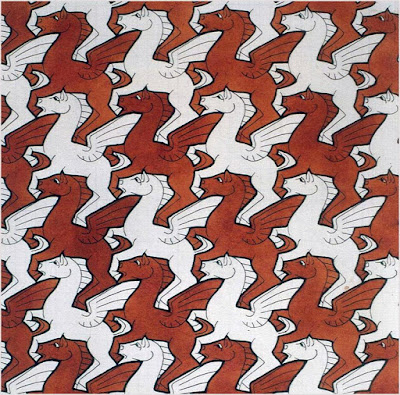Vision doesn't occur passively. It's active, constructive, and largely unconscious.
And it doesn't happen all at once. Sometimes it takes a half second to process an image, and sometimes it takes a second or two.
The light entering our eyes is translated and organized in stages, beginning with simple visual elements and proceeding to higher levels of interpretation. These stages of image processing start in the retina and continue in different parts of the brain.
For us to be able to see the flying white horses, our brain must segment the image and relegate the dark red shapes to the background, rather than vice versa.This kind of sorting normally happens unconsciously, but it's easy to intentionally flip the one set of horses from figure to ground and back again.
Identifying the figure as a mythological flying horse and the whole pattern as a piece of art by M.C. Escher is the final and most sophisticated stage in image processing, involving several areas of the brain.
Eric R. Kandel et al., authors of a textbook on the Principles of Neural Science, describe the process this way:
Book: Principles of Neural Science  by E.R. Kandel, et al.
by E.R. Kandel, et al.
Eric R. Kandel et al., authors of a textbook on the Principles of Neural Science, describe the process this way:
"The brain analyzes a visual scene at three levels: low, intermediate, and high. At the lowest level, visual attributes such as local contrast, orientation, color, and movement are discriminated. The intermediate level involves analysis of the layout of scenes and of surface properties, parsing the visual image into surfaces and global contours, and distinguishing foreground from background. The highest level involves object recognition. Once a scene has been parsed by the brain and objects recognized, the objects can be matched with memories of shapes and their associated meanings."


تعليقات
إرسال تعليق